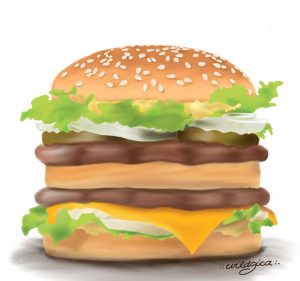16 Writing the Concluding Paragraph
Learning Objectives
After completing the exercises in this chapter, you will be able to
- identify the components of a concluding paragraph
- learn how to conclude your paper with impact
In the chapter on introductions, you learned that the introductory and concluding paragraphs are like the top and bottom buns of a hamburger. They contain basically the same information and are critical for holding the entire piece together. Now we’ll focus on the concluding paragraph.
Essay Structure
You learned previously that an academic paragraph is structured like one big burger!

The top bun is the introduction.
The meat and vegetables in the middle are the supporting body paragraphs (several mini-burgers).
The bottom bun is the conclusion.
“Burger” by wildgica under license CC BY-NC-ND 3.0.
The top and bottom bun are both made of bread; they contain the same ingredients (or information) but look a little bit different. The “meat” of your argument is in the supporting body paragraphs.
Concluding Paragraph Structure
The most important thing to remember about the conclusion is that it shouldn’t state any new information. The purpose of the concluding paragraph is to summarize the main points of your argument.
The concluding paragraph has three main goals:
- Restate your stance on the topic
- Summarize the main topics (from the body paragraphs) that support your stance
- Close the essay effectively with a powerful final statement
Your final statement might be a general thought about the topic, a prediction that is logically based on the evidence you presented in the supporting paragraphs, or a call to action in which you ask the reader to do something in light of the persuasive information you’ve presented.
Examples:
- general thought: Nuclear power is a far greater resource than many people realize.
- prediction: Nuclear power will be the energy of the future.
- call to action: Governments need to invest in nuclear power so it can reach its full potential.
Watch this video to learn some great tips for how to write a great concluding paragraph[1]:
While Mister Messinger says your conclusion can be more than one paragraph, most teachers are expecting a one-paragraph conclusion, so it’s best to stick to just one paragraph!
Sample Concluding Paragraph
One really effective strategy is to link your conclusion to your introduction by continuing an idea that was introduced in the introductory paragraph. Look below at the introductory and concluding paragraph for the essay on raising chickens.
Introductory Paragraph:
When asked to name a pet, most people think of dogs and cats. Some might consider hamsters, fish, or reptiles. Many people would never consider keeping chickens as domestic animals within the city limits, but “backyard chickens” can be a great addition to the households of urban families who have a modest backyard. However, the City of Thunder Bay currently does not allow chickens to be kept within city limits because residents are concerned that chickens are too loud and dirty and even dangerous for city life (Mortfield, 2016). Mortfield (2016), who participates on the Thunder Bay and Area Food Strategy administration committee, said these “NIMBYists” (people who say ‘not in my backyard’) stand in the way of progress, and their misconceptions about keeping chickens are preventing Thunder Bay residents from reaping the benefits of raising these “pets with a purpose” (para. 24). The City of Thunder Bay should amend the existing bylaw that prevents raising chickens within city limits so that urban dwellers can have food in their backyards, practice being more environmentally friendly, and enjoy unique opportunities for companionship.
The writer begins her introductory paragraph with a hook; she tries to engage the reader in her topic by asking the reader to imagine their ideal pet, and then provides a surprising answer: chickens as a pet! She then provides sufficient background information so that the reader can understand the existing laws and issues surrounding urban chicken ownership. Finally, she provides her thesis (in bold and colour-coded). The thesis clearly states the topic (backyard chicken ownership), her stance (it should be allowed), and the reasons for her stance (the three topics of the body paragraphs: chickens as food, chickens as eco-friendly options, and chickens as special pets).
Concluding Paragraph:
In conclusion, the benefits to owning a backyard chicken are numerous, making chickens the best pet of all. Chickens provide owners with a fresh and highly nutritious source of free and convenient protein. They are also eco-friendly as they produce helpful organic waste, can assist in recycling household organic waste, and can reduce dependency on the cruel and environmentally unfriendly practices of factory farming. Finally, chickens can make excellent companions and raising them can be very beneficial for people with special needs. Clearly, city bylaws should be revised to enable urban residents to raise chickens in their backyards.
The writer starts by restating her thesis (in bold): she reminds readers of her topic (raising chickens) and her point of view (that raising chickens is beneficial). She also reminds the reader of the hook she used in her introductory paragraph: chickens as pets!
The writer then restates, or summarizes, the reasons she’s given for her point of view. She basically provides a one-sentence summary of each of her body paragraphs. Notice that the writer doesn’t need to include any citations here because she isn’t introducing any new or highly specific information.
The writer ends with a call to action (in orange). She tells the readers what she thinks the next step should be, based on the research she’s presented. The final statement, prediction, or call to action shouldn’t come as a surprise to the reader – the final thought is completely logical based on the information presented throughout the paper.
- Mister Messinger. (2020, August 19). End your essay (part 1): How to write a conclusion paragraph [Video]. YouTube. https://www.youtube.com/watch?v=lv8tLxFVGuw ↵

